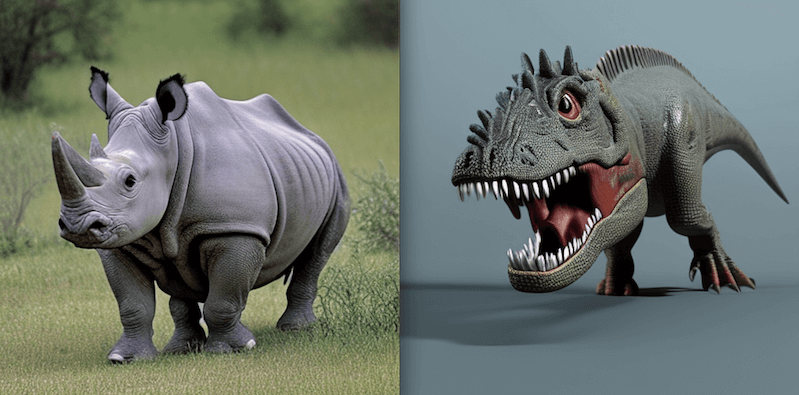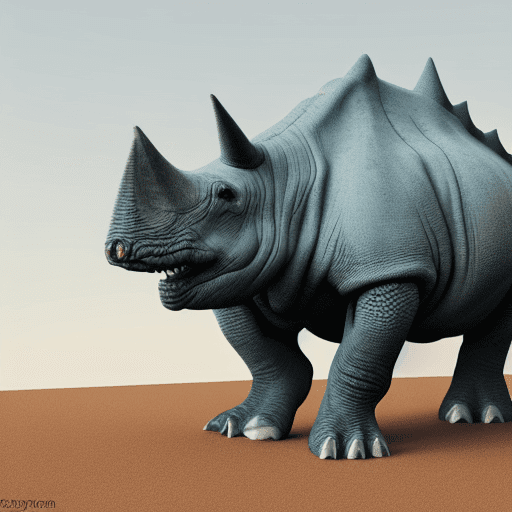Is a rhino a dinosaur?
There is a lot of debate over whether or not a rhino is a dinosaur.
Some people say that because dinosaurs are defined as “a group of animals that includes all the descendants of the first reptiles to evolve from amphibians,” and since rhinos evolved from mammals, they cannot be considered dinosaurs.
However, others argue that because dinosaurs are classified by their skeletal structure, and not by their evolutionary history, then any creature with a similar skeletal structure they could be called a dinosaur.
So, what is the truth?
Are rhinos dinosaurs?
Let’s take a closer look at this question and see what the real experts have to say…

No, a rhino is not a dinosaur.
Explain It To A Child
No, a rhino is not a dinosaur. Rhinos are large, herbivorous mammals that are closely related to horses and tapirs. They first appeared during the Miocene epoch, which began around 23 million years ago.
Dinosaurs are extinct reptiles that roamed the earth millions of years ago. Rhinos, on the other hand, are large mammals that live in Africa and Asia.
Is a rhino a dinosaur?
No, a rhino is not a dinosaur.
Rhinos are actually large, herbivorous mammals that are closely related to horses and tapirs.
They first appeared during the Miocene epoch, which began around 23 million years ago.
Dinosaurs, on the other hand, went extinct around 65 million years ago. While it may be easy to confuse the two animals based on their size and appearance, there are several key differences between rhinos and dinosaurs.
For example, rhinos have hooves, while dinosaurs had claws.
Additionally, dinosaurs were reptiles, while rhinos are mammals.
As a result, it is clear that these creatures belong to different groups.
What are the similarities and differences between rhinos and dinosaurs?
Rhinos and dinosaurs may seem like two very different creatures, but they actually have a lot in common.

Both are large, herbivorous animals with thick skin and a single horn on their snouts.
However, there are also quite a few differences between the two.
- For one thing, dinosaurs lived millions of years ago, while rhinos are still alive today.
- Dinosaurs also come in a wide variety of shapes and sizes, while all rhinos are roughly the same size.
- Finally, dinosaurs lived on land, while rhinos live on the water.
Despite their many differences, rhinos and dinosaurs share a number of similarities that make them both fascinating members of the natural world.
What dinosaur is similar to a rhino?

The rhinoceros is a massive animal, with a thick hide and two horns on its snout.
It is one of the few living animals that bears a strong resemblance to a dinosaur.
In fact, the rhino is often thought to be a living dinosaur, due to its similar size and appearance.
However, there are several key differences between the two animals.
- For one, dinosaurs were armed with sharp teeth and claws, while rhinos have only blunt molars for grinding vegetation.
- Additionally, dinosaurs were fast runners, while rhinos are relatively slow.
Despite these differences, the rhinoceros is still an impressive animal, and its similarity to dinosaurs makes it all the more fascinating.
While rhinos are not dinosaurs they are closely related to them, sharing some common characteristics.
How do experts determine whether a rhino is or is not a dinosaur?

In order to determine whether a rhino is a dinosaur, experts must first look at its anatomy.
One of the key features that distinguish dinosaurs from other reptiles is the presence of a hole in the hip socket, which is necessary for accommodating the large bones of the thigh.
Rhinos do not have this feature, meaning that they are not true dinosaurs.
However, rhinos do share some other characteristics with dinosaurs, such as their size and weight, as well as their habit of walking on all fours.
Additionally, both groups of animals lived during the Mesozoic Era.
For these reasons, some experts consider rhinos to be closely related to dinosaurs, even though they are not technically classified as such.
Why rhinos are called living dinosaurs?
Rhinos are massive, horned mammals that are often referred to as living dinosaurs.
While they may resemble their ancient relatives, they actually belong to a different family of animals.
So, why do they get this nickname?
One reason is that they have been around for a very long time.
Rhinos first appeared on Earth over 50 million years ago, making them one of the oldest mammal groups still in existence today.
Additionally, rhinos have remained largely unchanged since their early days. Unlike many other animals, they have not evolved much over the millennia, making them true living fossils.
Finally, rhinos are endangered species, and there are only a few thousand left in the wild.
Unless we take action to protect them, these fascinating creatures could soon be lost forever. For all of these reasons, rhinos are rightly called living dinosaurs.
What is the rhinos’ habitat?
The rhinos are native to the eastern and southern parts of Africa, where they can be found roaming savannas, grasslands, and woodlands.
They are also present in small numbers in Nepal, India, and Bhutan.
The three main species of rhinoceros are:
- The Black Rhino
- The White Rhino
- The Greater One-Horned Rhino
The black rhino is the smallest of the three and has a pointed horn.
The white rhino is the largest and has a square lip.
The greater one-horned rhino is intermediate in size and has a single horn that is slightly curved.
All three species are herbivores and prefer to eat grasses and foliage. Rhinos are social animals and live in small groups called herds.
The size of a herd varies depending on the species but typically consists of 3-5 individuals. Herds are led by a dominant male, who protects the females and their young from predators such as lions and leopards. Rhinos are at risk of extinction due to habitat loss and poaching.
Their horns are prized for use in traditional Chinese medicine, resulting in hundreds of animals being killed each year. Conservation efforts are ongoing in order to protect these iconic animals from disappearing completely.
Article Sources
Jacks of Science sources the most authoritative, trustworthy, and highly recognized institutions for our article research. Learn more about our Editorial Teams process and diligence in verifying the accuracy of every article we publish.
